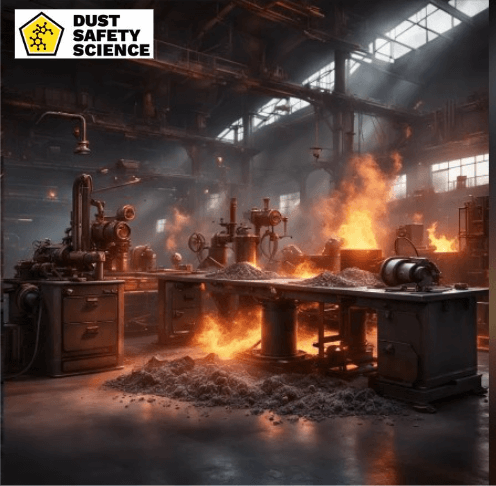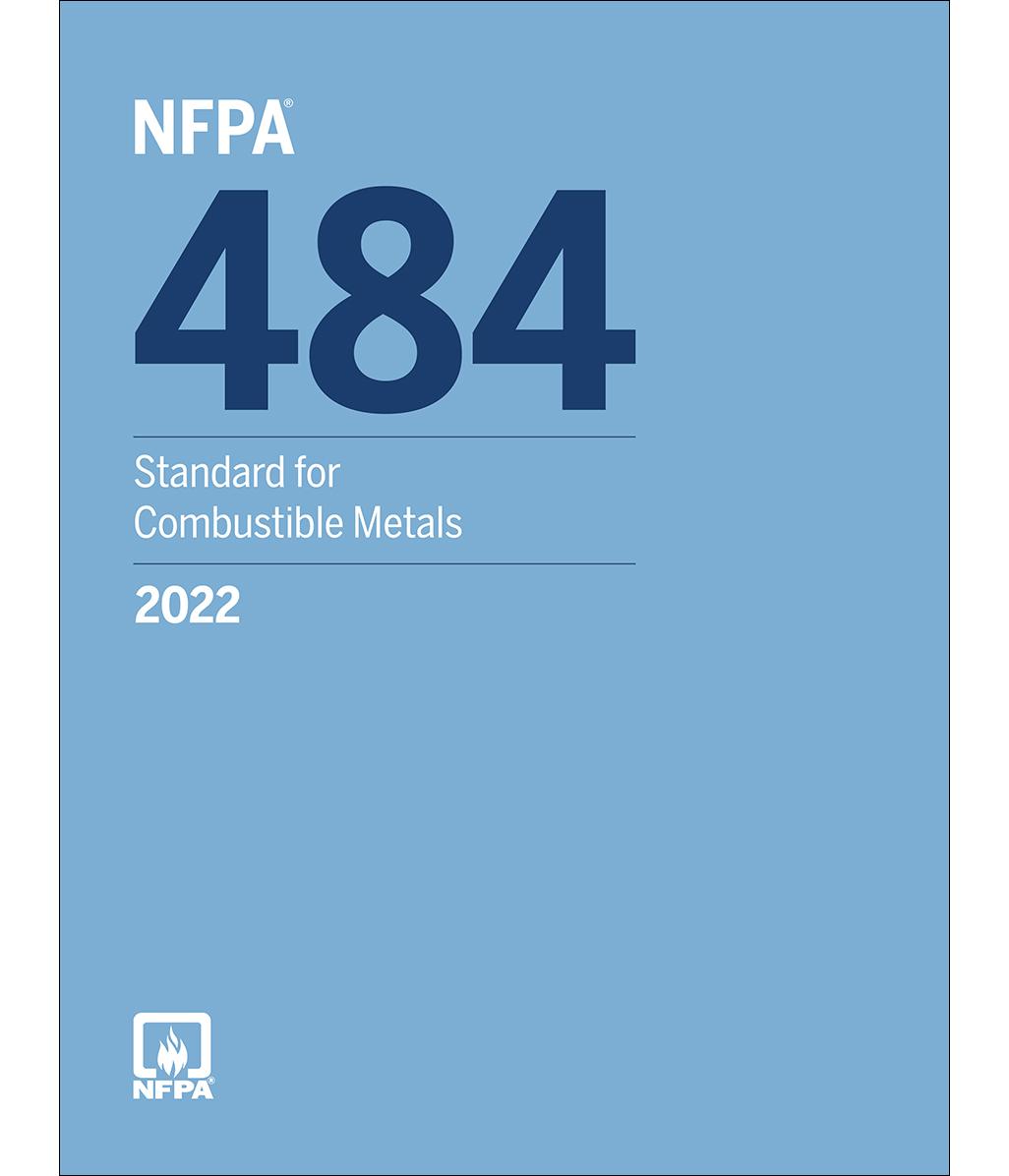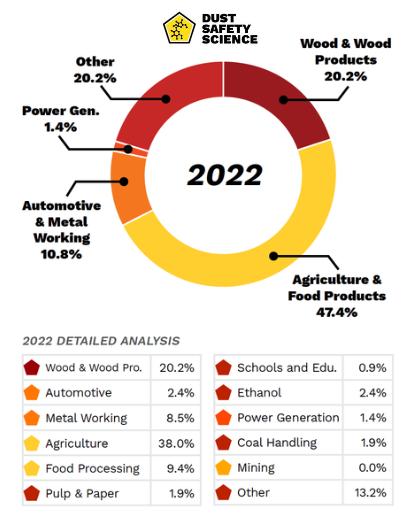Updated September 19, 2024 Authored by Dr. Chris Cloney and Jon Barrett of Dust Safety Science

A picture of a Combustible Dust Fire and Explosion, inside a Metal Working Manufacturing Facility
Key Takeaways:
- Industry Dynamics: The metalworking industry operates within an environment where various processes generate combustible metal dusts, creating a unique set of challenges. Grinding, cutting, polishing, and welding, these activities release fine particles into the air, which can accumulate in a dust collector and pose a significant risk of dust explosions. The industry’s dynamics require tailored strategies for effective dust management to ensure a safe workplace and loss prevention.
- Hazards of Combustible Dust: One of the primary hazards in the metalworking industry is the potential for combustible metal dust explosions. These combustible metal dusts, toxic dusts, and explosions can lead to severe consequences, including health risks to people, injuries, fatalities, and extensive damage to facilities, requiring environmental remediation.
- Specific Concerns: A notable concern in the metalworking industry is the diverse range of metals used in manufacturing. Different metals exhibit varying combustion properties, with some, like aluminum, being highly combustible dusts, causing dust clouds, leading to metal dust fires, and a potential dust explosion.
Combustible Metal Dust Hazards, in the Metal Working Industry:
Modern metalworking processes, though diverse and specialized, can be categorized into one of three broad areas known as forming, cutting, or joining processes. The Occupational Safety and Health Administration, (OSHA), identifies Metal as a Combustible Dust. Fine particles of metal dusts, with a very small particle size, are generated during various stages of metal processing, such as cutting, grinding, and polishing constitute the primary source of combustible dust in these facilities. The intricate processes involved in metal manufacturing, such as grinding, polishing, and cutting, generate fine metal dust that, when suspended in the air in sufficient concentrations, can ignite and lead to devastating explosions. Accumulation of metal dust in a dust collector is also an explosion hazard, requiring dust control. The metal sector, also encompasses various processes from machining to welding, as these processes generate fine metal dust capable of forming combustible dust. These minute particles of metal dust often suspended in the air within industrial settings, create a volatile environment where the potential for ignition and subsequent explosions becomes a significant concern. Specifically, when water is mixed or added to aluminum dust, a chemical reaction occurs, causing a potential dust explosion.
Other metal dusts examples include metal include Iron, Tin, Lead, Copper, Mercury, Silver, Gold, Steel, Aluminium, Copper, Magnesium, Nickel, Titanium, Zinc, Brass, and Bronze. Metals like zirconium, aluminum, magnesium, and titanium are particularly notorious for producing combustible dust due to their fine particle sizes. Understanding the nature of these dust particles, their composition, and the conditions under which they become combustible is essential for developing effective strategies to mitigate the associated hazards, with metal dust explosions.
Several factors contribute to the heightened dust hazards in the metal industries and metal equipment manufacturers. The inherent flammability of certain metals, coupled with the fine nature of the generated metal dust particles, and accumulation of metal dust collection in a dust capture system, creates an environment conducive to rapid combustion. Additionally, other combustible materials in the industrial setting, such as oils and lubricants, further elevate the risk. Metal powders are also used for fireworks, pyrotechnics, rockets, and as propellants. The combination of these factors that generate metal dust, along with inadequate ventilation systems, dust capture, and a dust capture system, can result in dust piles and the formation of explosive mixtures. Recognizing and addressing these key factors, with a risk assessment of the process equipment and machining process, are crucial steps in enhancing safety protocols and minimizing the potential for catastrophic incidents and combustible dust explosions in metal processing facilities. In addition, Metal dust fires require Class D fire extinguishers and agents. Water used as an extinguishing agent can actually intensify a metal dust fire. NFPA 484 mentions having Class D metal dust fire extinguishers ‘within easy reach’ of the processing equipment.
Mitigating combustible dust hazards in the metal sector requires a comprehensive approach that integrates preventive measures and industry best practices. Implementing effective housekeeping routines to control metal dust piles, investing in dust collectors and high efficient dust collection systems to capture airborne particles, and utilizing explosion-resistant equipment is essential. Additionally, employee training and awareness programs play a vital role in fostering a safety-conscious culture within the industry. Regular inspections, adherence to safety standards, and the incorporation of advanced technologies for control of dust and metal dust collection, such as a maintained and inspected dust collection system, further contribute to creating a secure working environment. By understanding the intricacies of dust hazards in the metal industries and proactively adopting preventive measures, stakeholders can safeguard both personnel and facilities from the potentially devastating consequences associated with these hazards.

A picture of the NFPA 484 Guide to Combustible Metals
Metal Working Industry Specific Concerns and Root Causes with Combustible Dust
The metalworking industry faces specific concerns related to dust, posing potential threats to both workers and facilities. Most people in the metal process industries are not aware that combustible metal dust is a byproduct of various metalworking processes, such as grinding, polishing, and welding, where fine metal dust, metal oxides, and other metal dust types and substances can accumulate in a dust collector, or dust collection system, and in the air as a dust cloud. These microscopic particles can form explosive mixtures when combined with air in certain concentrations, and certain conditions, creating a significant explosion hazard in the metalworking environment.
One primary concern in the metalworking industry is the risk of dust explosions. Combustible dust explosions can result in devastating consequences, causing injuries, fatalities, and extensive damage to facilities. Metalworking processes often generate fine particles that can easily become airborne and settle in hard-to-reach areas, increasing the likelihood of dust accumulation and a dust cloud. Effective dust management, a dust collection that can handle explosive dust, and control of dust measures are crucial to mitigate the risk of explosions, including regular cleaning of workspaces, proper ventilation systems, and the use of dust collection systems provided by a certified dust collector supplier.
Another specific concern is the diversity of metals used in the metalworking industry. Different metals and different materials have varying properties, and some may pose a higher risk of combustion or explosion than others. For example, aluminum dust is one type of highly combustible dust form and poses a greater risk compared to steel dust. In addition, Appendix F of the NFPA 86 combustible dust standard,
presents relatively high numbers for Pmax and Kst values stated for Aluminum and Magnesium. This diversity necessitates a tailored approach to dust management, considering the specific characteristics, and representative sample of the metals involved in the manufacturing processes. Regular risk assessments, an internal hazard investigation board, and training programs are essential to educate workers about the potential metal fires and hazards associated with specific metal dust and how to handle them safely. The National Fire Protection Association, NFPA 484, NFPA 484, Standard for Combustible Metals (2022), and the NFPA 122 Standard for Fire Prevention and Control in Metal/Nonmetal Mining and Metal Mineral Processing Facilities also serve as guidelines for combustible metal dust in manufacturing facilities.
Performing a Dust Hazard Analysis, and Root Causes with Combustible Dust
The metalworking industry must address concerns related to metal dusts and metal fires
to ensure a safe working environment. By implementing a dust hazard analysis, with specifically designed and effective dust collectors and metal dust collection, explosion venting, explosion suppression control measures, conducting a regular risk assessment, and providing adequate training, the industry can minimize the risk of combustible dust hazards, metal dust fires, and explosions and protect the well-being of workers and facilities. from hazardous dust. In addition, The National Fire Protection Association, NFPA 484, NFPA 484, Standard for Combustible Metals (2022), can assist with providing combustible dust standards to mitigate dust explosions. All facilities that produce or handle combustible dust, need to perform a dust hazard analysis. The intricate machinery and dust involved in these operations, such as a metal dust collection system, conveyor belt, and motor bearings, increases the risk of friction or mechanical sparks as an ignition source, which, when combined with the combustible metal dust suspended in the air, heightens the potential for metal fires and catastrophic incidents.

A picture of a detailed analysis and percentages of several Industries, including Metal Working, affected by Combustible Dust, from Dust Safety Science
Historic Metal Working Industry Related Combustible Dust Explosions
Dust incidents, continue to occur worldwide and in the Metal sector, as presented in this combustible dust research and incident database from Dust Safety Science. In addition, statistics of the most prevalent industries, regarding combustible metal dust incidents, are also captured in this Annual Incident Report Database, from Dust Safety Science. During 2022, Metal Dust occurred in 8.5% of dust incidents. In addition, the Dust Safety Science Podcast educates the public on Metal Dust Explosion Loss History, Severity & Practical Considerations. Some of the historic Metal industries’ combustible metal dust explosions and incidents include:
- PEPCON disaster (1988): While not exclusively in the metal working industry, the PEPCON, (Pacific Engineering Production Company of Nevada), a disaster occurred in Henderson, Nevada. PEPCON manufactured ammonium perchlorate, a key component of solid rocket fuel. On May 4, 1988, a massive explosion erupted at the PEPCON facility, triggered by a fire that ignited combustible aluminum dust. The explosion caused extensive damage to nearby buildings and homes, with shockwaves felt miles away. Two people were killed, hundreds were injured, and the blast left a massive crater in the desert. The incident underscored the dangers of combustible dusts in manufacturing and industrial settings, including those involved in metal processing. Potential preventative and mitigative measures were implemented as a result of this explosion. Additionally, lessons learned from this explosion disaster can be implemented into future public awareness and safety process hazard analysis. Combustible Dust Process safety management policies and procedures can also be updated.
- Hayes Lemmerz International (2003): An explosion at the Hayes Lemmerz International aluminum wheel manufacturing plant in Huntington, Indiana, claimed the lives of one worker and injured several others. Combustible aluminum dust was identified as the primary fuel for the explosion, highlighting the risks inherent in metal processing facilities.
- AL Solutions Metal Dust Explosion (2010): According to the US Chemical Safety Board, the December 9, 2010 accident at the West Virginia facility that milled and processed scrap titanium and zirconium metal killed three employees and injured a contractor. “As the metals were broken down during milling, the risk of a metal dust fire or explosion increased as the metal particles decreased in size. At AL Solutions a metal blender used to process zirconium was having mechanical problems that had not been adequately repaired. As a result, the blender was producing heat or sparks due to metal-to-metal contact.” ………………………………………………………………………………………………………………………………………
- Hoeganaes Corporation (2011): A series of explosions devastated the Hoeganaes Corporation’s iron powder plant in Gallatin, Tennessee. The explosions, ignited by combustible iron dust, resulted in the tragic loss of five lives and numerous injuries, highlighting the severe hazards posed by metal related combustible dust.
- Powderpart Inc., a Woburn 3-D printing company, (2013): An OSHA inspection followed an explosion and fire on Nov. 5, 2013, which inflicted third-degree burns on a company employee. OSHA’s Andover Area Office found that the company failed to prevent and protect its workforce from the fire and explosion hazards of reactive, combustible metal powders, such as titanium and aluminum alloys, which are used in the company’s three-dimensional printing process.
